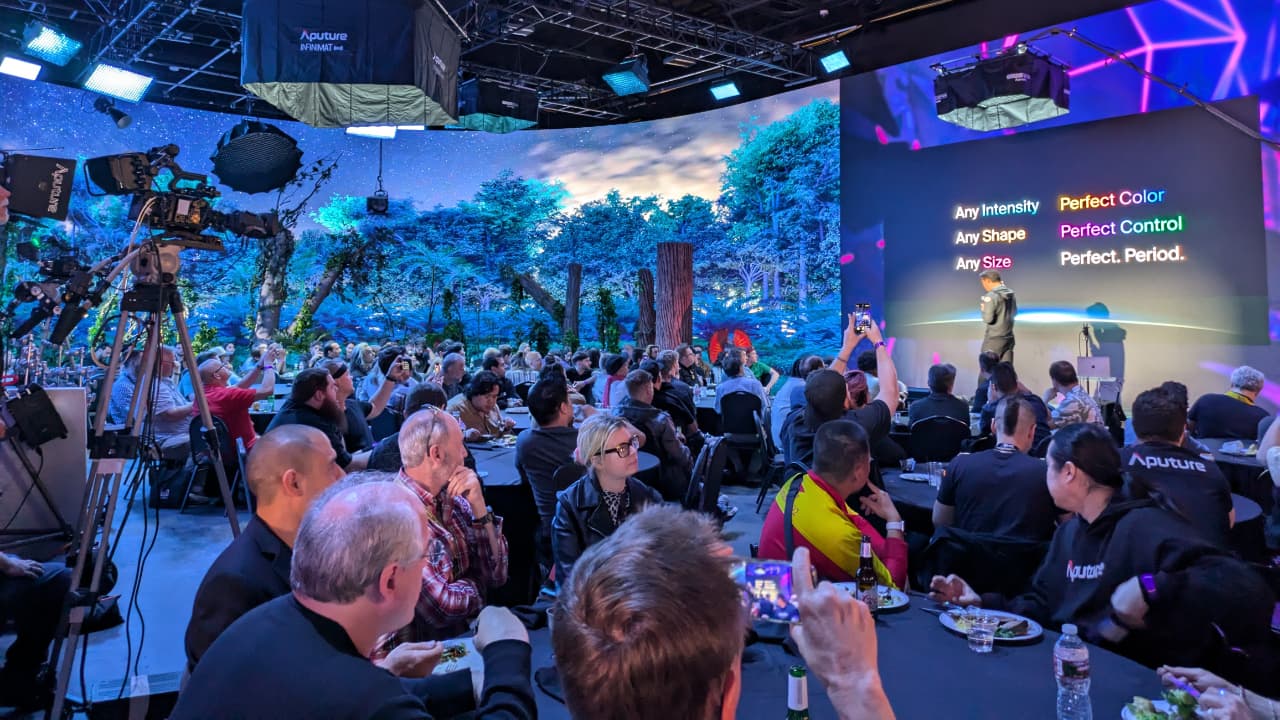
Once upon a time LED lights could just be plugged into a wall. That is increasingly not the case, but amidst the race for more and more power ideas still count.
There was a time, not a few years ago, when the NAB show floor was dominated by vast LED video walls. The trend now seems to be that there are fewer huge ones and more small ones, a phenomenon which seems not to be so provoked by disinterest in the technology but by its normalisation.
Which is a breath of fresh air, because for a long time, virtual production has been more or less the only moviemaking technique that people seem to want to become less special. It can work so well, and so many people want to use it, but they don’t want to bury the production in truckloads of gear and thereby turn the process into a nightmare of complexity. It is becoming increasingly clear that only a minority of productions will (or practically can) involve every possible aspect of virtual production. Many simply treat the video wall as a (much) better sort of back projection, and save vast amounts of money on car interiors as a result.
None of this stopped Aputure throwing a party at Vū’s virtual production stage in Las Vegas this week, although image-based lighting was not at the top of its agenda. The headline goes to the 5.2kW (yes, five and a bit kilowatt) monster which the company previewed at the BSC show. LED lighting has been an arms race for a long time, and clearly there’s a degree of one-upmanship going on. That has served brands like Aputure, Godox, Nanlux and others well for a decade, although the 2025 NAB show seems - in terms of both products on show and the speculation around them - to represent something of an inflection point.
Power games

As soon as Aputure built its 2.6kW light, it made something which at least some of the world can’t plug into the wall. With the 5.2kW option, it built something that absolutely nobody can plug into the wall. That inevitably has the effect of limiting these products to productions which are operating on stages or with generator support, which vastly, vastly changes the audience and the scale of the market.
Let’s be clear: these lights needed building, and something in the 18kW range still needs building, and they are likely to be essential and popular products. The fact that some of the more established incumbents of high-end equipment have not yet done this is perhaps something of a surprise.
What won’t be a surprise is the fact that the market for these lights is vastly, vastly different to the group of customers who have propelled these companies onward. People in the market for a 100-watt light are young, enthusiastic and extremely numerous. People in the market for a 1000-watt light are likely to be a bit less young, a bit more careful, and really quite a bit less numerous. Those likely to have a real need for a 5kW, and perhaps an eventual 18kW or 20kW option, will be established companies regularly serving seven-, eight- or nine-figure productions of which there are just a few every year.
The upshot of all this is that the lighting market is about to change, albeit in ways which will challenge manufacturers more than users. Users can simply keep buying what they buy, but manufacturers must perpetually find a way to offer people things they want without simply engaging with the escalation of power levels which have characterised the market since its inception.
The continual need for ideas

So, much as with cameras and lenses, NAB 2025 suggests that the future of lighting will involve good ideas as much as more photons. Even then, the imposing Aputure XT52 includes several sophistications, not least of which is the simple fact that its power supply (ballast, if you like) is not the half-ton wheeled monstrosity that we might have expected. This is a concomitant of a newer, better DC power supply design, and the fact that the pulse-width modulation part of the LED channel control is in the head rather than the control box. The light is also based around Aputure’s excellent BLAIR lighting engine for high-quality colour mixing, and has niceties such as the option to limit maximum settings to the available power, so as not to overload, say, a 5kW generator.
There’s still plenty to do in LED lighting - fades that go smoothly all the way down to black, more deep red, and an alternative to Aladdin’s stupendously-useful Fabric Light which is - frankly - just less expensive.
In the long run, though, it barely matters who does the fabled 18k LED first. It wasn’t NAB 2025, but the technology is scalable enough that 2026 doesn’t see out of the question. One way or another, someone will do it, and at that point, the arms race will be well and truly over.
Tags: Production Lighting Aputure NAB 2025


Comments